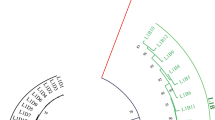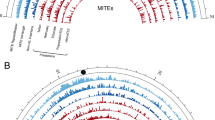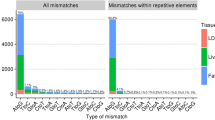Abstract
Transposable elements are mobile genomic sequences that comprise a large portion of mammalian genomes. The transposable element fusion phenomenon within porcine genes has not yet been reported; therefore, we investigated transposable element fusion genes in the Sus scrofa genome. Porcine transposable element-mediated chimeric transcripts were identified and characterized. Most transposable elements preferentially inserted themselves into an antisense orientation and into the 3’ end of porcine genes. The transposable element fusion gene between porcine mRNA and ERV class I, one of the LTR retrotransposons, was not detected. This data will be of great use to further studies focused on a better understanding of the biological function of porcine genes in relation to transposable elements.
Similar content being viewed by others
References
Akiyoshi DE, Denaro M, Zhu H, Greenstein JL, Banerjee P and Fishman JA (1998) Identification of a full-length cDNA for an endogenous retrovirus of miniature swine. J.Virol. 72: 4503–4507.
Almeida LM, Silva IT, Silva WA Jr, Castro JP, Riggs PK, Carareto CM and Amaral ME (2007) The contribution of transposable elements to Bos taurus gene structure. Gene 390: 180–189.
Ashburner M, Ball CA, Blake JA, Botstein D, Butler H, Cherry JM, Davis AP, Dolinski K, Dwight SS, Eppig JT, et al. (2000) Gene ontology: tool for the unification of biology. The Gene Ontology Consortium. Nat. Genet. 25: 25–29.
Bae JH, Ahn K, Nam GH, Lee CE, Park KD, Lee HK, Cho BW and Kim HS (2011) Molecular Characterization of Alternative Transcripts of the Horse BMAL1 Gene. Zoolog. Sci. 28:671–675.
Baltimore D (1985) Retroviruses and retrotransposons: the role of reverse transcription in shaping the eukaryotic genome. Cell 40: 481–482.
Biemont C and Vieira C (2006) Genetics: junk DNA as an evolutionary force. Nature 443: 521–524.
Capomaccio S, Verini-Supplizi A, Galla G, Vitulo N, Barcaccia G, Felicetti M, Silvestrelli M and Cappelli K (2010) Transcription of LINE-derived sequences in exercise-induced stress in horses. Anim. Genet. Suppl. 2: 23–27.
Cohen CJ, Lock WM and Mager DL (2009) Endogenous retroviral LTRs as promoters for human genes: a critical assessment. Gene 448: 105–114.
Cordaux R, Udit S, Batzer MA and Feschotte C (2006) Birth of a chimeric primate gene by capture of the transposase gene from a mobile element. Proc. Natl. Acad. Sci. USA 103: 8101–8106.
Finnegen DJ, (1989) Eukaryotic transposable elements and genome evolution. Trends Genet. 5: 103–107
Gentles AJ, Wakefield MJ, Kohany O, Gu W, Batzer MA, Pollock DD and Jurka J (2007) Evolutionary dynamics of transposable elements in the short-tailed opossum Monodelphis domestica. Genome Res. 17: 992–1004.
Humphray SJ, Scott CE, Clark R, Marron B, Bender C, Camm N, Davis J, Jenks A, Noon A, Patel M, et al. (2007) A high utility integrated map of the pig genome. Genome Biol. 8: R139.
Klymiuk N, Müller M, Brem G and Aigner B (2006) Phylogeny, recombination and expression of porcine endogenous retrovirus gamma2 nucleotide sequences. J. Gen. Virol. 87: 977–986.
Krane DE and Hardison RC (1990) Short interspersed repeats in rabbit DNA can provide functional polyadenylation signals. Mol. Biol. Evol. 7: 1–8.
Lander ES, Linton LM, Birren B, Nusbaum C, Zody MC, Baldwin J, Devon K, Dewar K, Doyle M, FitzHugh W, et al. (2001) Initial sequencing and analysis of the human genome. Nature 409: 860–921.
Lorenc A and Makalowski W (2003) Transposable elements and vertebrate protein diversity. Genetica 118: 183–191.
Makalowski W, Mitchell GA and Labuda D (1994) Alu sequences in the coding regions of mRNA: a source of protein variability. Trends Genet. 10: 188–193.
Medstrand P, van de Lagemaat LN and Mager DL (2002) Retroelement distributions in the human genome: variations associated with age and proximity to genes. Genome Res. 12: 1483–1495.
Phelps CJ, Koike C, Vaught TD, Boone J, Wells KD, Chen SH, Ball S, Specht SM, Polejaeva IA, Monahan JA, et al. (2003) Production of alpha 1,3-galactosyltransferase-deficient pigs. Science 299: 411–414.
Piriyapongsa J, Polavarapu N, Borodovsky M and McDonald J (2007) Exonization of the LTR transposable elements in human genome. BMC Genomics 8: 291.
Platt JL (2000) Hyperacute rejection: fact or fancy. Transplantation 69: 1034–1035.
Sandelin A, Carninci P, Lenhard B, Ponjavic J, Hayashizaki Y and Hume DA (2007) Mammalian RNA polymerase II core promoters: insights from genome-wide studies. Nat. Rev. Genet. 8: 424–436.
Sela N, Kim E, and Ast G (2010) The role of transposable elements in the evolution of non-mammalian vertebrates and invertebrates. Genome Biol. 11: R59.
Singer SS, Mannel DN, Hehlgans T, Brosius J, and Schmitz J (2004) From “junk” to gene: curriculum vitae of a primate receptor isoform gene. J. Mol. Biol. 341: 883–886.
Smit AF (1999) Interspersed repeats and other mementos of transposable elements in mammalian genomes. Curr. Opin. Genet. Dev. 9: 657–663.
van de Lagemaat LN, Landry JR, Mager DL and Medstrand P (2003) Transposable elements in mammals promote regulatory variation and diversification of genes with specialized functions. Trends Genet. 19: 530–536.
Varagona MJ, Purugganan M and Wessler SR (1992) Alternative splicing induced by insertion of retrotransposons into the maize waxy gene. Plant Cell 4: 811–820.
Waterston RH, Lindblad-Toh K, Birney E, Rogers J, Abril JF, Agarwal P, Agarwala R, Ainscough R, Alexandersson M, An P, et al. (2002) Initial sequencing and comparative analysis of the mouse genome. Nature 420: 520–562.
Wiedmann RT, Nonneman DJ and Keele JW (2006) Novel porcine repetitive elements. BMCGenomics 7: 304.
Author information
Authors and Affiliations
Corresponding author
Additional information
H.-S Ha and J.-W. Moon contributed equally to this work.
Electronic supplementary material
Rights and permissions
About this article
Cite this article
Ha, HS., Moon, JW., Gim, JA. et al. Identification and characterization of transposable element-mediated chimeric transcripts from porcine Refseq and EST databases. Genes Genom 34, 409–414 (2012). https://doi.org/10.1007/s13258-011-0212-0
Received:
Accepted:
Published:
Issue Date:
DOI: https://doi.org/10.1007/s13258-011-0212-0




